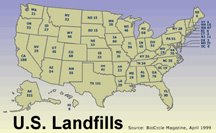Senator pushes for fixes at dump
The Akron Beacon Journal
PIKE TWP - State Sen. J. Kirk Schuring, R-Jackson Township, said Wednesday he intends to push the Ohio Environmental Protection Agency to delay its recommendation on a 2007 operating permit for the Countywide Recycling & Disposal Facility.
The reason: concern that a large fire may be burning -- and spreading -- under part of the 258-acre landfill in southern Stark County. Such a fire could create serious health and safety hazards for workers, neighbors and potentially 600,000 people who use water from an aquifer in east-central Ohio.
Schuring said delaying approval of the permit might force the landfill to close temporarily, but it would get the attention of Republic Waste Services of Ohio, which owns the landfill in Pike Township.
Once the problems -- the possible fire and the foul odors that have plagued the area for months -- are fully investigated and corrected, Schuring said, the permit could be issued.
"We've heard a lot of things,'' Schuring said, "but we haven't seen the action that we need at Countywide.''
Schuring, whose district includes the landfill, said he intends to ask Christopher Korleski, the new director of the EPA, for the delay. The EPA is expected to make a recommendation within weeks to the Stark County Health Department, which decides whether to issue the permit.
The EPA announced Tuesday that it will investigate whether an underground fire is burning at the dump, which is off Gracemont Street Southwest, just east of Interstate 77.
The EPA plans to review infrared images taken by Kent pilot Larry Davis and hire an expert on landfill fires from California, Todd Thalhamer, to help determine whether there is a fire and what needs to be done.
Aluminum waste
For months, Republic Waste Services and the Ohio EPA have said the odors and underground heat at the dump are the result of a chemical reaction involving aluminum waste. Liquid coming into contact with aluminum waste produces gases and heat, which causes garbage to decompose faster, generating more gases and odors.
Davis' infrared images indicate that the area of intense heat under the landfill increased 12-fold between August and December.
A smoldering underground fire could cause explosions, release toxic gases into the air and melt a dump's plastic liner. The liner, along with a layer of clay, keeps contaminated leachate, or liquid runoff, out of groundwater.
Owner's recent proposal
In August, Republic Waste Services offered a proposal for dealing with the aluminum waste problem, but it was rejected by regulatory agencies.
A review of EPA files indicates that the company, based on laboratory testing, wanted to inject a solution of magnesium chloride -- road-salt liquid -- under pressure into the dump to slow the chemical reaction and reduce odors.
But the plan was killed by federal and state agencies. Officials questioned whether it would work, and the agencies were nervous about adding a chemical into the landfill.
The plan was not discussed publicly.
Opposition group
Members of Club 3000, a citizens' group that has opposed the landfill for 17 years, are convinced that there is a fire.
Club President Dick Harvey and Vice President Tom O'Dell said the group is worried that a fire could ignite highly toxic liquid-laced auto fluff -- shredded dashboards and seats -- in the landfill. Burning fluff would release toxins into the air.
They said club members have observed smoke, not steam, coming from the landfill in their visits there for two to three years.
Harvey said of the company's response: "They say it's steam, but we all know the difference. We've seen smoke pouring out of the ground like a chimney.''
Waste Management, the previous owner of the facility, granted Club 3000 weekly access to the landfill to observe its operations under a 1990 agreement.
Allegations, responses
O'Dell said he recently videotaped what he believed to be boiling leachate from the landfill and was told about a worker who had been burned while loading leachate into a tanker truck.
O'Dell said that would be proof that the landfill is getting hotter and threatening the synthetic liner that sits under the garbage.
Countywide manager Tim Vandersall said there's no evidence of boiling landfill liquids or of anyone being injured.
He said O'Dell might have videotaped leachate that came into contact with landfill gases, and that could have produced a bubbling in the liquid.
The leachate at the bottom of the landfill closest to the synthetic liner has a temperature of 120 degrees, Vandersall said, and that's not hot enough to threaten the liner.
View related articles:
Ohio EPA delays Countywide decision again
EPA investigating whether Countywide's on fire
Possible fire at landfill probed
Countywide Recycling & Disposal Facility opened in 1991 and accepts…
More time needed to solve landfill stink













